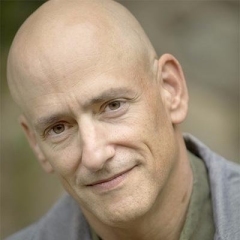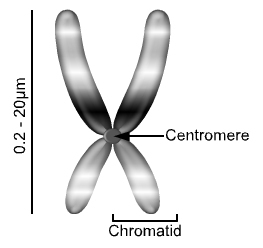Jay L. Wile's Blog, page 36
October 17, 2016
Secular Jew Becomes a Christian
Andrew Klavan is a prolific writer and commentator. (click for image source)
A very good friend of mine alerted me to a book that sounds incredibly interesting. It’s entitled, The Great Good Thing: A Secular Jew Comes to Faith in Christ, and it is written by Andrew Klavan, a rather prolific writer and political commentator. I have ordered the book and plan to review it as soon as I can, but I decided to do a bit of “background reading” first, and I ran across this thought-provoking interview that he did with Jews for Jesus. The interview is definitely worth reading in its entirety, but I wanted to share my thoughts about it.If you aren’t familiar with the organization, Jews for Jesus is a group of Jewish people who have come to realize that Jesus is the Messiah, and they want others to learn this as well. As a result, they do what they can to spread the Gospel within the Jewish community. Since Andrew Klavan is a reasonably famous Jewish person, it only makes sense for them to promote the fact that he has come to believe in Christ as the Messiah. What makes the interview interesting to me, however, is the fact that he described himself as a secular Jew before his conversion. In fact, he says:
After my bar mitzvah, I was done with the religious part of Judaism. Or any religion. I was always comfortable as a cultural Jew, though. I kind of liked being a bit of an outsider in that way. It didn’t mean very much to me but it was there. As for God, as I became more of an intellectual, I became an agnostic. For a brief, though important time, I was an atheist.
Note that he makes a distinction between being an agnostic and being an atheist. This is an important distinction that is (unfortunately) lost on many theists. An agnostic claims neither belief nor unbelief in God, while an atheist specifically says that he or she does not believe in God. Klavan is obviously aware of the difference, and if I am interpreting his words correctly, it seems that he went from agnostic to atheist and then back to agnostic again before becoming a Christian.
There were many aspects of his story that I found fascinating, but a couple of them really stand out. First, he says that he received thousands of dollars worth of gifts at his bar mitzvah, and at first, he really loved them. After several months, however, he became ashamed of them, because he realized that he had essentially lied in order to get them. By participating in a bar mitzvah, a Jewish boy is entering not only the Jewish community as someone who is responsible for his own actions, but he is also entering the Jewish faith as someone who is ready to observe the precepts of the faith and take part in public worship. Since he had no intention of doing those things, he felt that his bar mitzvah was a lie, so he actually threw away the gifts he received at it. That strikes me as a very mature act for a teenage boy!
Another really fascinating aspect of his story was how he came to believe. He said that he started reading the Bible when he was 15. He didn’t do it because he was seeking God, however. He did it because he wanted to be a writer, and he understood that the Bible is an important work of literature. Once again, that seems like a very mature action for a teenage boy! He shares an interesting incident related to this:
One day my father walked into my bedroom without knocking and caught me reading Luke’s Gospel. He was livid. He told me if I ever thought of converting he would disown me. I find this kind of funny now, when you think of what you could find your teenaged son reading if you burst in on him like that!
While he thinks the incident is funny, I find it rather telling. Earlier in the interview, he made it clear that his father did not believe in the religious aspects of Judaism. Nevertheless, his father became furious at the thought of him converting to Christianity. Why? Most likely it is because his father understood how important the religion of Judaism is to Jewish culture. Thus, he thought that by converting to another religion, his son would essentially be rejecting his heritage.
Andrew addresses this issue in what I consider to be the most fascinating statement he makes in the interview:
One of my biggest fears confronting baptism—took me five months to work through it—was I didn’t want anyone to think I was turning my back on Jews, trying to escape my Jewish identity. The default mode with some Jews is to assume you’re trying to “pass as gentile” or blend in or that you hate your Jewishness and are joining the enemy. All understandable, because the Jews are the most mistreated group of people on the face of the planet and some of that trouble has come out of Christian sources, which stinks. Oddly, though, accepting Jesus made me feel more Jewish than I ever had, religiously at least. I had no connection to the Old Testament particularly, until I accepted the New. (emphasis mine)
In other words, the New Testament gave him a reason to believe in the Old Testament, and as a result, he connects more with his Jewish heritage than he did when he had no belief at all. Isn’t that beautiful?
October 10, 2016
This Baby Has Two Mothers and A Father

What was done for one couple to produce a baby without Leigh Syndrome
(click for credit)
Modern medicine can do a lot of amazing things these days. Diseases that used to be a death sentence are now not only treatable, but sometimes even curable. Because of the marvels of modern medicine, I have been able to benefit from the company and wisdom of my parents for many more years than I would have if I had been born but a generation ago. However, there are times I wonder whether we should be doing some of the things that modern medicine makes possible. An article I recently read in the journal Science brought that question to my mind once again.
The article describes the work of Dr. John Zhang, the medical director at New Hope Fertility Center in New York, New York. He was working with a couple who had lost two children to Leigh Syndrome, a rare genetic disease that affects the nervous system. While there are different forms of this disease, some of those forms are the result of the mother’s DNA alone. The father’s genes don’t play a role at all.
How is that possible? Most of the cells in your body hold DNA in two different places. The nucleus of the cell contains most of its DNA, which is called nuclear DNA. Half of that DNA comes from your mother, and the other half comes from your father. However, there is a small amount of DNA stored in the cell’s mitochondria, which produce most of the energy that the cell needs to survive. They are represented by the blue, peanut-shaped structures in the illustration at the top of the post. This DNA is called mitochondrial DNA, and you get it only from your mother. As a result, any genetic disease that is produced by mitochondrial DNA is inherited solely from your mother.
This fact allowed Dr. Zhang to produce a baby that is mostly the biological child of the couple with whom he was working, but the baby is also partly the child of a second woman, who served as a donor of healthy mitochondrial DNA.
The basic procedure that Dr. Zhang used is illustrated at the top of this post. The donor provided egg cells. Those cells, of course, held her DNA in its nucleus and in its mitochondria. Zhang then removed the nucleus of that cell and replaced it with a nucleus from the mother who wanted to give birth to the child. The resulting cell had the nuclear DNA of the mother but the mitochondrial DNA of the donor. Because it contained the donor’s mitochondrial DNA, there was no risk of Leigh Syndrome for the child produced from the egg cell. This process was done on 5 egg cells, which were all fertilized with the father’s sperm.
One of the fertilized eggs did not develop, but four of them did. When they were examined, three of them were genetically abnormal. They didn’t have the correct number of chromosomes. However, one fertilized egg was genetically normal, so it was transferred to the mother, who carried the baby to term. The baby was delivered, and according to the abstract of a paper that Dr. Zhang is presenting at a conference:
The baby is currently 3 months old and doing well.
Assuming that Dr. Zhang is telling the truth, this baby boy truly has three parents. Like any other child, his father’s DNA makes up half of his nuclear DNA, and his mother’s DNA makes up the other half of his nuclear DNA. However, the child has another person’s DNA as well. His mitochondrial DNA is not from his mother or his father. It is from the donor. In actuality, however, the boy does seem to have some of his mother’s mitochondrial DNA. According to the abstract of Dr. Zhang’s talk, about 2% of the mitochondrial DNA collected from the baby’s tissues right after birth was from the mother, not the donor.
I really don’t understand this. I realize that people want to have children. However, couples can have children these days even if they aren’t able to get pregnant. My wife and I have a daughter who has no biological relationship to us whatsoever. We adopted her as a teen, but she is my little girl in every way. It doesn’t matter that she didn’t “come from” us. As a result, I have a hard time relating to the couple in this story. Why would this couple go to such much effort, expense, and moral ambiguity to have a child that is biologically related to them? I have never had biological children, but I cannot imagine loving any child more than I love my little girl.
I don’t think this kind of procedure should be done. The fact that the child has DNA from three parents isn’t the issue for me, however. If we don’t understand the relationship between nuclear DNA and mitochondrial DNA, it might become an issue. But for right now, the big problem I have with it is the initial results of the procedure. There were total of five fertilized eggs. One of them was unable to develop, so it might never have been a human life. However, four of them were able to develop into the blastocyst stage. From a scientific point of view, then, they were all human lives. Three of them were discarded, however, because they had the wrong number of chromosomes. As far as I am concerned, then, at least three human lives were snuffed out so that this couple could have a child that is biologically related to them.
I just don’t see how that is justifiable. What do you think?
October 7, 2016
A Demonstration of the Surface Tension of Water
I thought some of my readers might be interested in a demonstration that I worked up to show my thermodynamics students that surface tension can exert a force by which it can do work. The result is certainly not what you expect, and I think it is fairly dramatic.
October 4, 2016
Young-Earth Creationist Wins Lawsuit
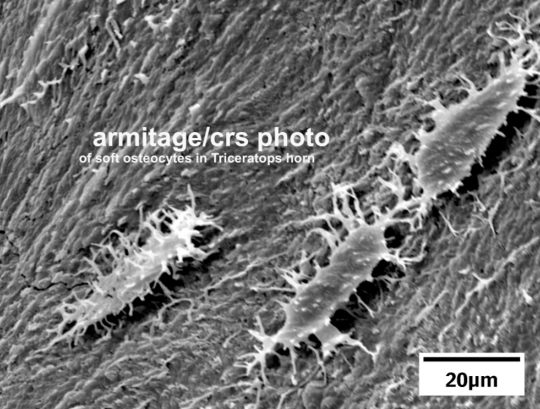
Electron microscope image of three soft bone cells from a dinosaur fossil
More than three years ago, I wrote about the sad story of Mark Armitage, a gifted scientist who has become an expert in microscopy. In addition to running his own microscope company, he also worked as the Manager for the Electron and Confocal Microscopy Suite in the Biology Department at California State University Northridge. While on a fossil dig in the Hell Creek Formation in Montana, he discovered a 48-inch Triceratops horn. When he and his colleague soaked it in weak acid to remove the mineral components, they recovered soft, brown tissue.
If that’s not exciting enough, he also examined the fossil with a scanning electron microscope, and he found actual bone cells! Not only that, he saw no evidence for mineralization in the cells. In other words, he wasn’t looking at cells that had gone through petrifaction. He was looking at cells that still had their original components. So not only had he found soft tissue in the fossil, he had found soft cells!
Obviously, this kind of find is amazing. Not surprisingly, he and his colleague, Dr. Kevin Lee Anderson, wrote a report on their discovery so that other scientists could learn from it. The report was published in the peer-reviewed, secular journal entitled Acta Histochemica.
Not long after that, the Darwinian Inquisition struck. He was fired from his position at California State University Northridge. As I reported previously, he decided to sue the university. Why? According to him, one faculty member stormed into his lab and shouted:
We will not tolerate your religion in this department, or your creationist projects either!
Armitage thus concluded that he was being discriminated against based on his religion.
Apparently, he was right, because his case has been settled, and he says that he is very pleased with the result.
I had the pleasure of speaking with Mr. Armitage yesterday, and I learned that the university’s initial response was that he had been fired for budgetary reasons. However, when university officials were questioned, it became clear that budgetary factors were not the real issue. The university attempted to argue that its actions weren’t discriminatory, but Mr. Armitage and his attorney weren’t convinced, so they wanted a jury to decide who was right.
As Mr. Armitage put it, they were about a week away from jury selection when the university said it wanted to settle the case. He says that they spent most of a day in court trying to negotiate for a smaller settlement, but he and his attorney were convinced that a jury would see that the university was in the wrong. As a result, he and his attorney were not willing to budge. Apparently, the negotiations ended with a lot of shouting and no agreement. Several days later, however, the university agreed to settle using Mr. Armitage’s terms.
According to Mr. Armitage, his discovery was well-known in the department long before he and Dr. Anderson published their scientific paper. Indeed, the biology department wrote about it in their newsletter long before the scientific paper was released. As a result, there were a lot of people interested in the discovery. Students would come down to his lab and ask to see the dinosaur cells. They would talk to Mr. Armitage about his discovery and ask him what he thought it meant. He would tell them that he thought it meant the Triceratops fossil couldn’t be millions of years old. He is convinced that’s why he was fired. The university didn’t want him telling students what he concluded based on his original scientific research.
As I mentioned previously, Mr. Armitage is very pleased with the result of his lawsuit. As he says:
This is a big win for those who are afraid of losing their jobs when they stand up for Scripture.
He also says he is very pleased with how most people react to his discovery. He says that when he has the occasion to tell people that he discovered a dinosaur fossil, most of them are intrigued and want to learn more. He says that he describes the Triceratops horn to them and then pinches the skin on his arm and tells them that he found soft tissue and cells in it. He then goes on to tell them what he thinks this indicates about the age of the fossils and the age of the earth in general. He says that this kind of discovery is an easy-to-understand piece of evidence for a young earth. In his words:
Soft tissue in dinosaur bones is a game-changer. The opposition is desperately trying to explain why it is there, and they are failing. It cuts through the noise. It cuts through the lies.
Even though he doesn’t have access to his university-based lab anymore, he is still continuing his work. Currently, he is gathering as many of the soft dinosaur cells as he can find so that he can slice them thin and see what is on the inside. This will provide a lot of insight into dinosaurs on a cellular level – something that has never been done before. Of course, this kind of research is expensive and time-consuming. If you would like to support his research, you can contact him through his Facebook page.
Mr. Armitage is currently working on a book that will discuss his entire run-in with the Darwinian Inquisition. Once it is published, I will read it as soon as I can and review it here.
September 26, 2016
I’m Not Surprised, But I’m Not Sure What It Means
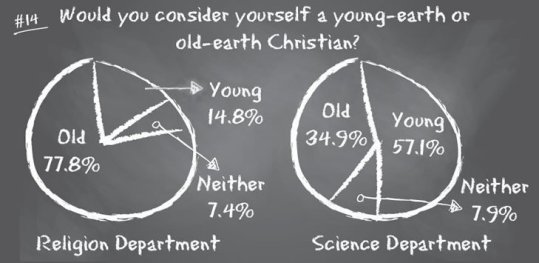
One of the many results of a poll taken at 200 conservative Christian colleges and universities. It indicates that the science faculty in those institutions are more likely to be young-earth creationists than their fellow religion faculty. (click for credit)
In 2011, Answers in Genesis published a book entitled Already Compromised. It was based on the results of an interesting poll. The pollsters (America’s Research Group and Britt Beemer) attempted to contact four faculty/staff members (the university president, the academic dean, the head of the science department, and the head of the religion department) at 200 different Christian colleges and universities. Of those potentially 800 people, they ended up being able to interview 312. They asked a wide variety of questions, focusing on how those individuals interpreted different aspects of the Bible. The results are presented in the book, along with ample commentary.
The conclusion of the book is that many Christian colleges and universities have “compromised” their theology, subordinating the teachings of the Bible to the scientific consensus. In other words, they have decided that they must force their interpretation of the Bible to “fit” the scientific consensus, which includes flagellate-to-philosopher evolution and a billions-of-years-old earth.
Now please understand that I do not agree with the conclusion of the book. I don’t think that those who believe the earth is ancient or that God has created through evolution are necessarily “compromising” their theology. Non-literal interpretations of various parts of the book of Genesis can be traced all the way back to (and before) the beginning of Christendom, and there are literal interpretations of Genesis that result in conclusions other than young-earth creationism. Thus, the whole idea that people who disagree with me when it comes to natural history are “compromised” is absurd.
Despite the fact that I disagree with the book’s conclusions, I am interested in the results of its poll, especially the one highlighted in the graphic above. According to the poll’s results on this issue, the heads of the science department in these 200 Christian colleges and universities are nearly four times more likely to be young-earth creationists than the heads of the religion department!
Is that surprising to you? It isn’t surprising to me. In fact, it is consistent with my general experience. Among the brothers and sisters in Christ with whom I am well acquainted, those who are educated in science are more likely to be young-earth creationists, and those who are not educated in science are more likely to be theistic evolutionists. Of course, my general experiences are not representative of Christianity as a whole, so it’s interesting to see the results of this poll.
Of course, this poll isn’t really representative of Christianity as a whole, either. Of those who were interviewed, 223 were from schools that belonged to the Council for Christian Colleges and Universities (CCCU), which tends to attract conservative evangelical institutions. The remaining 89 were from institutions that are associated with a particular denomination. In the end, then, I would say that this poll might be representative of conservative American Christianity, but not Christianity as a whole.
In addition, the sample size is rather small. Assuming the poll’s 312 participants were evenly spread out among the four positions targeted, each pie graph shown above represents results from only 78 people. That produces a statistical error of more than 11%. However, even with an error of 11%, the results are striking. Even if both pie graphs are off by a wide margin, their results still indicate that science faculty at conservative Christian institutions of higher learning are more likely to be young-earth creationists than the corresponding religion faculty.
What can explain these striking results? I think one factor is related to a person’s willingness to question the scientific consensus. Those who are well educated in the sciences understand that the scientific consensus is not always right. As a result, they are probably more willing to question it. Also, scientists have training in analyzing data, so they are more likely to actually look at the evidence presented by those who believe in an ancient earth or flagellate-to-philosopher evolution and examine it critically. Those whose expertise lies in other areas (such as language, history, or theology) are less likely to do such things, so they are more likely to believe the scientific consensus.
I suspect that there are other factors as well, but I am not sure what they are. I would love to conclude that the poll results tell us that young-earth creationism is the more scientifically-correct view when it comes to origins, but they obviously don’t tell us that. Science is not based on consensus. It is based on analyzing the data thoroughly and coming to the most reasonable conclusion you can based on those data. Even if only a tiny minority of scientists at conservative Christian colleges and universities were young-earth creationists, I would still consider it the most scientifically-correct view when it comes to origins, because I think the data speak very clearly on the matter.
I am interested in what you think. Do you have an explanation for why the poll ended up with such striking results?
September 19, 2016
More Confirmation of a Creationist Prediction
The centromere is the point at which a chromosome and its duplicate attach during cellular reproduction.
(click for credit)
One of the more stunning examples of a confirmed creationist prediction is given by the nature of DNA. Since the 1970s, evolutionists have taught (as an indisputable fact) that the majority of the human genome is made up of useless stretches of nonsensical sequences which have been collectively referred to as “junk DNA.” However, in a Herculean study of human DNA, the ENCODE team demonstrated that a minimum of 80% is used by the cell and therefore should not be referred to as “junk.” One of the scientists on the team (Dr. John A. Stamatoyannopolous) stated:
I don’t think anyone would have anticipated even close to the amount of sequence that ENCODE has uncovered that looks like it has functional importance…
Actually, there were several scientists predicting this very result! Creationists have been doing so for years.*
Well, now that we know the vast majority of the human genome is functional, some scientists have removed the evolutionary blinders from their eyes (at least when it comes to the nature of DNA) and have begun to look at regions of the DNA that scientists have been assuring us could not possibly have any function whatsoever. When they study such regions, they (not surprisingly) find that those regions do have a function, and it is often a very important one.
The latest example of this kind of study has been published in the online journal Genome Research. The scientists involved in the study analyzed regions of the human genome that contain what is known as “repetitive DNA.” This kind of DNA is composed of a sequence that is repeated over and over again. Specifically, the researchers looked at repetitive DNA that can be found around the centromeres of chromosomes.
If you have taken a high school biology course, you have probably seen drawings of chromosomes, such as the one that appears at the top of this post. The “X” shape that is familiar to many biology students actually represents two chromosomes (an original and its duplicate) which are attached to one another. This shape only appears during a few stages of cellular reproduction, after the DNA has been duplicated but before the cell has divided into two distinct emtities. During this time, the chromosome and its duplicate are attached to one another at the centromere, forming the shape of an “X.”
It was thought that the repetitive DNA found at the centromere occurred only once on each chromosome, and that sequence determined where the centromere would be found. However, the same research group involved in this study showed that’s not correct. In fact, many human chromosomes contain more than one sequence of the same repetitive DNA at different places on the chromosome. The centromere can form at any site that contains that repetitive sequence.
In this current study, the researchers focused on just one human chromosome (#17). They found that about 30% of the people they studied had variations in the repetitive DNA at the site where the centromere usually forms. For most of those people, the centromere forms at the alternative site. In other words, even though the sequence of DNA where the centromere forms is repetitive, it is important. Too many variations in that repetitive DNA, and the centromere has to go to an alternative site.
There are two important things to pull from this research. First, it is clear that for this chromosome (and presumably others), there is a “backup site” for the centromere. When you see something with a backup built right into it, what does that tell you? It tells you that design is involved. The hallmark of any well-designed system is a series of backups that allow the system to continue to work even when its primary processes fail. The very fact that at least some chromosomes have backup sites for their centromeres should tell you that the architecture of the chromosome is the result of design.
Second (and more important), you can see that this is a stunning confirmation that the DNA evolutionists have dismissed as “junk” is actually of vital importance. Think about it. When it comes to DNA, what could be more “useless” than a sequence that simply repeats over and over again? The information stored in DNA is based on variations in its sequences. A repeating sequence clearly contains very little information, right? Obviously not. If a variation in that sequence results in the centromere being built somewhere else, the sequence is obviously of vital importance.
Unfortunately, because of the blinders installed by evolution, repetitive DNA sequences such as the ones analyzed by this research team have been ignored for far too long. As the lead scientist on the team said in a press release:
What we found in this study is probably the tip of the iceberg…There could be all sorts of functional consequences to having variation within the complex, repetitive portion of the genome that we don’t know about yet.
Hopefully, this team’s research will induce others to take off the blinders of evolution when it comes to the nonsensical idea of junk DNA. For right now, however, we can say that this group’s research is continuing to confirm the predictions of creationists when it comes to the nature of DNA.
September 12, 2016
The Difference Between Energy and Power

As I have mentioned before, I am teaching a thermodynamics class at Anderson University. The first few lectures were mostly composed of review. It is important to do such a review, because some concepts are so critically important that I must be sure the students remember them and understand them well. Whenever possible, I like to do demonstrations to help the students visualize the concepts I am trying to get them to understand.
One of my very favorite demonstrations involves something surprising that happens when you burn natural gas in just the right way. It can be used to illustrate several different things, but I used it in my thermodynamics class to illustrate the concept of power. I hope you enjoy it:
September 7, 2016
Another Atheist Who Became a Christian
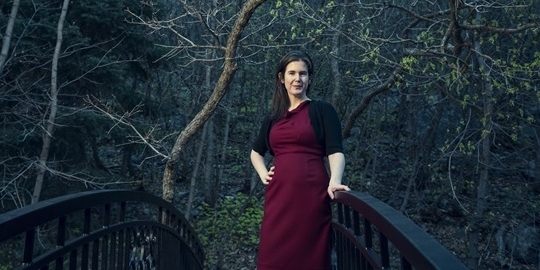
Nichole Cliffe wrote about her conversion in Christianity Today.
(click to view the article, from which this image is taken)
I have been pretty busy with the thermodynamics class that I have been teaching at Anderson University, as well as finishing up the last book in my elementary science series. As a result, I haven’t had a lot of time to write blog posts. However, I did want to share a very interesting article that I recently saw in Christianity Today. It is about another atheist who became a Christian. Her name is Nichole Cliffe. She is a journalist who grew up in Canada and went to Harvard University. She has written for different websites, including Slate, The Hairpin and The Toast, a website she co-founded.
As long-time readers of this blog know, I collect these kinds of stories, because I am fascinated by the many ways that God reveals Himself to people. This one is a bit different from the others that you will find here, however, because it has little to do with science or philosophy. Indeed, the author has no regard for apologetics. She says that coming to Christ involved figuring out what she already knew. It’s an interesting viewpoint, and I encourage you to read what she has to say:
August 29, 2016
More “Ancient” DNA Found
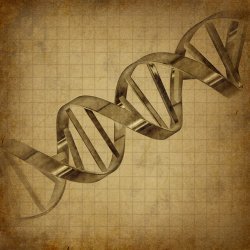
DNA that is thought to be more than a million years old has been discovered in the Bering Sea. (illustration by Lightspring via shutterstock.com)
Over the weekend, I read a fascinating paper published in Geology, the peer-reviewed journal of the Geological Society of America. The authors of the paper report on their attempts to extract DNA from the sediments found at the bottom of the Bering Sea. They were successful in their attempts to find DNA, even in sediments that are supposed to be 1.4 million years old! This is a rather surprising discovery, since the half-life of DNA in bone is supposed to be about 521 years. In fact, the experiments done to obtain that half-life indicate that even at very low temperatures, no meaningful DNA could be extracted from bone after 1.5 million years.So why is it surprising that the authors of this study found DNA in sediments that are supposed to be “only” 1.4 million years old? There are at least two reasons. First, wet sediment should accelerate the decay of biological molecules (including DNA) compared to the inside of a bone. Thus, DNA should become undetectable much earlier in wet sediment. Second, their results indicate that there would still be DNA found in much “older” sediments, because the “older” the sediment in their study, the more the DNA seem to resist decay.
But wait a minute. This is wet sediment. All manner of microorganisms can infiltrate wet sediment. How do we know that this DNA has really been in the sediment since it was formed? Couldn’t the DNA they detected be from microorganisms that recently started living there? That’s one of the clever aspects of this experiment. The authors looked at DNA that is found in the chloroplasts of cells that do photosynthesis! Since such organisms require light to survive, they wouldn’t have any reason to infiltrate the dark sediments. Even if they did get into those sediments for some reason, they would die in the upper layers, so the deeper (and therefore older) sediments definitely would not harbor any recent microorganisms that had such DNA.
In the end, it seems to me that they really did extract from the sediment DNA that had been there since that sediment had formed. That’s interesting enough, but there is something even more fascinating about what the authors found.
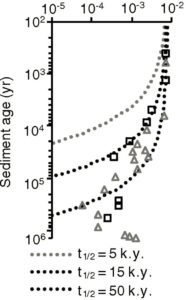 The graph on the left is a slightly modified version of the authors’ Figure 3A. It shows the fraction of chloroplast DNA found versus the assumed age of the sediment. The squares represent what was found in sediment from one site, while the triangles represent what was found in sediment from another site. The various dotted curves show what one would expect if the DNA was decaying the way a biological compound typically decays. They each use a different half-life (5,000 years, 15,000 years, or 50,000 years), but they allow you to compare the data to what is expected based on our knowledge of how DNA decays. Notice that the data don’t follow any of the curves. The “older” the sediment, the “slower” the DNA seems to decay. The authors note this:
The graph on the left is a slightly modified version of the authors’ Figure 3A. It shows the fraction of chloroplast DNA found versus the assumed age of the sediment. The squares represent what was found in sediment from one site, while the triangles represent what was found in sediment from another site. The various dotted curves show what one would expect if the DNA was decaying the way a biological compound typically decays. They each use a different half-life (5,000 years, 15,000 years, or 50,000 years), but they allow you to compare the data to what is expected based on our knowledge of how DNA decays. Notice that the data don’t follow any of the curves. The “older” the sediment, the “slower” the DNA seems to decay. The authors note this:
As described in the Results section, for both sites, the relationship of cpDNA sequence fractions to age best fits a power law (Fig. 3B). This suggests that residual cpDNA is more resistant to degradation in older sediment.
(NOTE: “cpDNA” is their abbreviation for the DNA found in chloroplasts)
The authors suggest that perhaps the older the sediment, the lower the activity from bacteria and other dark-loving microorganisms. That might decrease the rate of DNA decay. Also, they suggest that perhaps some of the DNA is better protected than the rest. For example, some algae (the diatoms) form cell walls made from silica. Theoretically, their DNA should be more resistant to decay than the DNA found in algae that don’t make such cell walls. So maybe the DNA is not decaying as expected because there are several different rates of DNA decay in the sediment, and the only thing they can see is the mixture of all those rates.
I find both of those possible explanations unsatisfactory. The first one is almost certainly not right, because deep sediments support a wide variety of microbial life. The second one probably isn’t right, either. The authors specifically say that chloroplast DNA from diatoms is present in the deeper layers. At some point, you should get to sediment that is old enough that the poorly-protected DNA has decayed away and mostly diatom DNA is left. At that point, the data should follow one of the curves. However, the data never end up following the curves, even in the very “old” sediment.
There is another way to explain what the authors see. If the age of the sediment is calculated wrongly, you wouldn’t expect the data to follow the curves. To me, that’s the more likely explanation. However, more studies will need to be done to figure this out. For example, it would be interesting to see the same kind of graph made exclusively for chloroplast DNA from diatoms. This should give us results for only the better-protected DNA. If my interpretation of the data is correct, you still wouldn’t see anything like the expected decay pattern.
I hope that the authors (as well as others) continue this very interesting line of inquiry.
August 25, 2016
Another Earth-Like Planet? Not Really.

An artist’s conception of the newly-discovered planet, Proxima Centauri b
(click for credit)
The internet is alive with exciting news. Space.com says that astronomers have discovered the “Closest Earth-Like Planet.” New Scientist says, “Earth-like planet spotted just 4 light years away.” Livescience.com says, “Found! Potentially Earth-Like Planet at Proxima Centauri Is Closest Ever.” So we’ve finally found an earth-like planet, right? Wrong!
The European Southern Observatory, whose astronomers actually found this new planet, is much more measured in its public announcement of their find. While it gives a few illustrations (like the one above) that are based almost exclusively on imagination alone, the announcement itself carefully discusses what is actually known about the planet. As far as they can tell, this planet is most likely a rocky planet (unlike Jupiter, Saturn, Uranus, and Neptune, which are mostly gas), and it is also possible that the temperature of the planet allows for the existence of water in its liquid phase, which most scientists think is necessary for life. Thus, it is possible that life might exist on the planet.
How did the astronomers at the The European Southern Observatory come to this conclusion? First, they observed the nearest known star to our sun, Proxima Centauri, for an extended amount of time. By analyzing changes in the light that comes from that star, they found that it “wobbles.” Sometimes, it moves towards the earth at about 3 miles per hour, but eventually, it turns around and starts moving away from the earth at about the same speed. This happens repeatedly at intervals of about 11 days. Pretty much the only way this can be explained is if a planet is orbiting the star, tugging it one way and then another as it orbits. Using this information and our understanding of gravity, the mass of the planet (currently being called “Proxima Centauri b”) has been calculated to be at least 30% more than that of earth, and its average distance from Proxima Centauri is about 4 million miles, which puts it 20 times closer to its star than earth is to the sun.
Right now, that’s really all that can be said about the planet with any degree of certainty. However, based on those calculations, some conjectures can be made.
It is hard to understand how a gaseous planet with a mass anywhere near that of earth could be stable so close to a star, so based on the mass of the planet and its distance from Proxima Centauri, astronomers speculate that it must be rocky. Now please understand that the planet itself has not been observed directly. Astronomers conclude it is there and calculate its characteristics based on the way the star Proxima Centauri moves back and forth. Thus, we don’t know that the planet is rocky, but we can say that it probably is.
Also, based on the amount of light that comes from Proxima Centauri and the distance this planet is from the star, it is possible that the planet (or parts of it) stay in a temperature range that would allow water to exist in its liquid form. In contrast to the speculation that the planet is rocky, however, the speculation that it might contain liquid water is very, very uncertain. The star that it orbits is very different from the sun. It is fainter, which is why the planet must be so close to its star to possibly have a temperature that is suited for the presence of liquid water. However, even if there is liquid water, the planet probably has little in common with earth, specifically because it is so close to its star.
For example, the planet either has no day/night cycle, or the day/night cycle is like that of Mercury. Why? When a planet is close to its star, the tidal forces that act between the planet and star tend to “lock” the planet into one of two kinds of rotation. One possibility is that the speed of the planet’s rotation is perfectly synchronized with the speed of its orbit, so the same part of the planet is always facing the star. If this is the case, the planet would have no day/night cycle at all. One side of the planet would always be light, and the other side would always be dark. The other possibility is more complex, where the planet makes three rotations for every two orbits. That’s what it is like for Mercury, which results in a day/night cycle that is very, very different from that of the earth.
Also, because Proxima Centauri b is so close to its star, it is hit with a lot more ultraviolet radiation and X-rays than the earth. In order for life to exist, it must be protected from this dangerous electromagnetic radiation. One way that could happen is for the planet to have an atmosphere that includes gases which absorb such radiation. However, because it has to absorb so much more radiation, the composition of the atmosphere would have to be very different from that of earth’s atmosphere. Alternatively, the life could exist only underground (where it is protected from the radiation), but once again, that would make it much different from earth.
Obviously, a lot more study has to be done to find out what this planet is like and whether or not it might harbor liquid water and/or life. However, based on what we know right now, it is most likely nothing like earth!
Jay L. Wile's Blog
- Jay L. Wile's profile
- 31 followers


